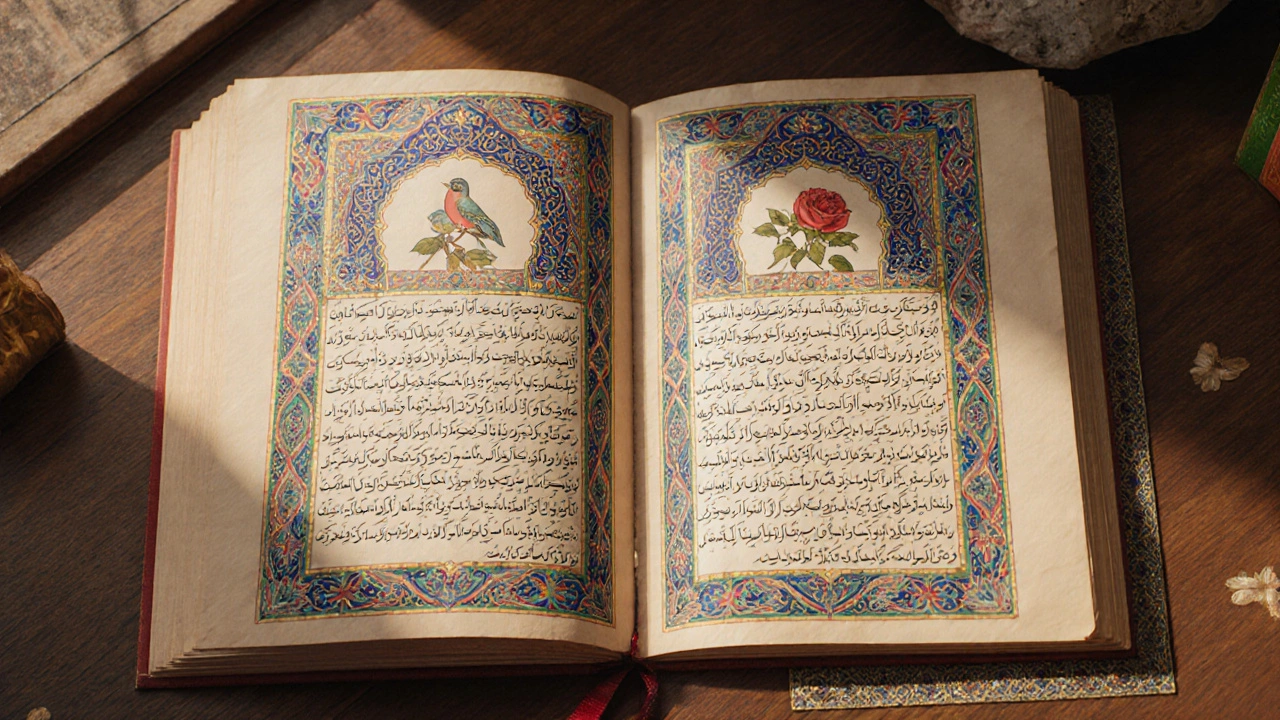English Name for a Ghazal: Meaning, Translation & Examples
 Oct, 23 2025
Oct, 23 2025
Key Takeaways
- A ghazal is a lyrical poem originating in Persian and Urdu literature.
- There is no exact one‑word English equivalent; it is usually called a “ghazal” in English.
- English translations aim to keep the couplet structure, rhyme, and emotional tone.
- Common English descriptors include “lyric poem” or “love poem,” but they do not capture the full form.
- Understanding the ghazal’s technical elements helps translators render it faithfully.
Ever stumbled across a beautiful two‑line stanza in a collection of Indian poetry and wondered what the whole form is called in English? You’re not alone. Many readers see the word “ghazal” and assume it needs a direct English synonym, but the reality is richer and a bit more nuanced. Below we break down what a ghazal actually is, why translators often keep the original name, and how you can spot a ghazal in English‑language anthologies.
Ghazal is a short, lyric poem consisting of rhyming couplets and a refrain, traditionally expressing love, longing, or mystic yearning. It emerged in Persian courts before becoming a staple of Urdu and South‑Asian poetry.
Historical Roots of the Ghazal
The ghazal’s ancestry lies in Persian poetry, where it first appeared around the 10th century. Persian poets like Rudaki and Hafez refined the form, embedding spiritual and romantic themes. By the 13th century, the ghazal migrated to the Indian subcontinent, flourishing in Urdu poetry. Notable Urdu masters such as Mirza Ghalib and Faiz Ahmad Faiz elevated the ghazal to a vehicle for social commentary and personal introspection.
Structural Elements That Define a Ghazal
Every authentic ghazal shares several technical features. Knowing them helps both readers and translators grasp why the form resists a simple English label.
- Couplet (or Sher) - Each line pair is a self‑contained unit, often offering a complete thought.
- Rhyme scheme - The second line of every couplet ends with the same rhyme (the radif) preceded by a repeating refrain (qaafiyaa).
- Metre (or Beher) - All lines follow a strict rhythmic pattern, usually 10‑14 syllables.
- Refrain - A recurring word or phrase that appears at the end of the second line of each couplet, binding the poem together.
- Takhallus - The poet’s pen‑name, often woven into the final couplet as a signature.
How the Ghazal Appears in English
When you see a ghazal in an English anthology, the translator usually retains the original name because it signals a specific poetic tradition. However, descriptors like ghazal English translation appear in scholarly works and online collections to guide readers.
English renderings focus on three goals:
- Preserve the couplet’s independent meaning.
- Recreate the rhyme‑and‑refrain pattern, even if it means altering word order.
- Convey the emotional intensity-whether it’s passionate love or spiritual yearning.
Because English lacks a built‑in refrain mechanism, translators often opt for a near‑equivalent rhyme scheme or use line‑breaks to hint at the original structure.

Common English Descriptors Used for a Ghazal
While “ghazal” remains the standard term, you’ll encounter a few English phrases that attempt to capture its essence:
- Lyric poem - Highlights the personal, emotional tone.
- Love poem - Reflects the genre’s frequent focus on love and longing.
- Ode - Occasionally used when the ghazal praises a higher power or abstract concept.
- Couplet series - Emphasizes the structural aspect of linked couplets.
None of these fully replace “ghazal,” but they help English‑speaking audiences set expectations before diving in.
Illustrative Examples and Their English Renderings
Below are excerpts from two celebrated ghazals, followed by popular English translations. Notice how the couplet integrity and the refrain are kept as much as possible.
Original (Urdu) - Mirza Ghalib
हजारों ख्वाहिशें ऐसी कि हर ख्वाहिश पे दम निकले,
बहुत निकले मेरे मक़सद न धरती से जुड़े।Translation - A. Khan
Thousands of desires, each a breath‑stealing plight,
Many I pursued, yet none were earth‑bound right.
The translation keeps the two‑line structure, mirrors the rhyme in “right,” and preserves the wistful tone.
Original (Persian) - Hafez
اگر آن ترک شیرازی بدست آید
به خال هندوی هم درآید.Translation - R. Sons
If that Shirazi Turk should be yours to win,
Even a Hindu’s beauty bears your kin.
Here the translator matches the Persian rhyme pattern while retaining the couplet’s playful spirit.
Tips for Translating a Ghazal into English
- Map the metre first. Count syllables in the original to guide line length.
- Identify the refrain. Decide whether to keep it verbatim or adapt it for rhyme.
- Preserve the couplet independence. Each two‑line segment should stand alone.
- Choose a consistent rhyme scheme. Even if you can’t replicate the exact radif, a steady rhyme helps the reader sense the pattern.
- Reflect the poet’s voice. Ghalib’s sarcasm, Faiz’s activism, or Hafez’s mysticism should shine through.

Related Poetic Forms: A Quick Comparison
| Feature | Ghazal | Sonnet | Ruba'i |
|---|---|---|---|
| Origin | Persian/Urdu | Italian (Shakespeare) | Persian |
| Structure | Couplets (2‑line units) with refrain | 14 lines, 4‑part (iambic pentameter) | Quatrain (4 lines) with AABA rhyme |
| Themes | Love, mysticism, loss | Love, philosophy, mortality | Ephemeral moments, philosophy |
| Rhyme Scheme | aa ba ca da… (radif + qaafiyaa) | ABAB CDCD EF EF GG | AABA |
Seeing the ghazal side‑by‑side with the sonnet or ruba'i underlines why a single English word rarely does it justice.
Frequently Asked Questions
Is there an English word that exactly means “ghazal”?
No single English term captures the ghazal’s unique blend of couplet structure, refrain, and lyrical intensity. Translators usually keep the word “ghazal” and add a brief description if needed.
Can a ghazal be written directly in English?
Yes. Contemporary poets write ghazals in English, adhering to the couplet‑refrain rule while using English metre and rhyme. Notable examples appear in modern literary journals.
Why do translators keep the original Persian or Urdu words sometimes?
Certain terms-like radif (refrain) or takhallus (pen‑name)-carry cultural weight that has no direct English parallel. Keeping them preserves authenticity.
What is the typical length of a ghazal?
Ghazals usually range from five to fifteen couplets, though some historic examples exceed twenty. The length allows the poet to explore a theme from multiple angles.
How does the refrain affect the mood of a ghazal?
The repeated refrain creates a hypnotic pulse, reinforcing the central emotion-be it yearning, joy, or melancholy-each time the couplet returns to it.
Next Steps for Curious Readers
If you’re keen to explore more, start with classic collections: Ghalib’s Diwan‑e‑Ghalib, Hafez’s Divan, or Faiz’s modern verses. Look for bilingual editions that present the original script alongside an English translation; they give the best sense of how the form works.
When you encounter a new poem labeled “ghazal,” remember it’s more than just a love poem-it’s a centuries‑old lyrical tradition that still thrives today. Happy reading!